poll results: only 2% of LiveJournals download music legally
The results of the poll " Where do people
get the music and video " HIGHLIGHTS
=== Of every 10 LJ stories, one downloaded a lot, six - only for free, three sometimes paid.
=== Only 2% of those polled legally downloaded music ...
ABOUT THE POLL The
poll began on April 7, 2007. For three weeks, 262 Russian-speaking LJ users took part in it.
57% of them live in Russia, 27% in the USA, 16% in the rest of the world.
I selected the American survey participants from the San Francisco Bay Area as a separate group because of the higher concentration of computer-literate people in these parts. Residents of the Bay Area accounted for 14% of the total number of respondents, the rest of America - 13%.
About terminology about downloading:
- free - This is from a donkey, newsgroups, torrent, regional network, as a souvenir on a self-written blank from a friend, copied from the library, etc., where you are not charged anything for accessing these files;
- not free - it’s for money, but less than usual in official American stores like iTunes, i.e., for example, on allofmp3.com, delit.net, mp3spy.ru, getmusic.ru, yanga.ru, etc. n., - everything that may be legal in Russia, but definitely angers copyright holders in America;
- legally - this is when a song is for 99 cents or more, an episode of a TV show for two green rubles, and a movie for 10 ... 15, OR music and movies from a rental office or library (not in copies), OR recorded on a DVR when you pay for this service to a cable provider, OR purchased in an ordinary store, OR in Ibei, but in a real box / package, etc.
MUSIC The
poll once again confirmed that the world is changing.
CDs replaced vinyl records once. Now they are being superseded by mp3 files, which often get from the Internet to computers and then to players, bypassing physical media. When asked why they play music most of the time, 57% of respondents said they listen to music on a computer; 29% are in mp3 players (while 20% are in flash players, the rest are in players with built-in hard drive). Thus, for 87%, audio files have already become what a couple of dozen years ago for the majority were vinyl records and compact cassettes.
 Chart 1
Chart 1
(all charts can be opened in a separate window - they will be easier to read)
* * * *
Those who spend a lot of time at the computer spend money on arranging the world in which they live - it happens that they pay for downloading music. Those who are at the computer no more than two hours a day are much more likely to get music off-line, but they don’t pay for downloading.
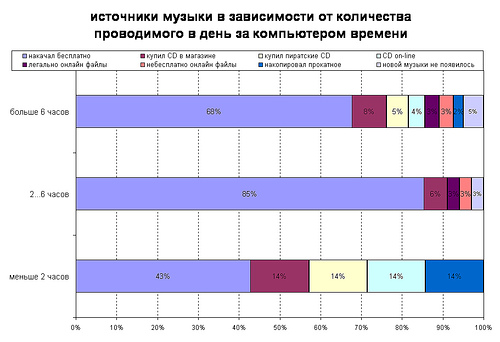 Chart 2
Chart 2
* * * *
Free download of music among Russian-speaking users of LiveJournal is widespread - 92% of those who answer are able and find where to download, not paying attention to legality.
58% of the survey participants downloaded only for free, 34% sometimes paid. Only 2% of respondents downloaded only legally. 6% did not download at all.
 Chart 3
Chart 3
Upon closer inspection, 92% of downloads look free, however, less impressive: most of them download quite a bit. 53% of respondents received up to 3 albums per month (by all means - uploading, copying, buying in off-line stores, etc.).
 Chart 4
Chart 4
Only 9% downloads a lot of music for free. “Many” are the many dozens of new albums that have appeared in their last three months.
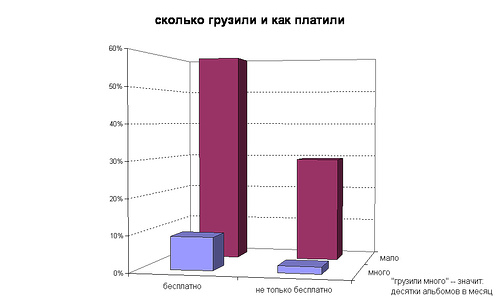 Chart 5
Chart 5
VIDEO
Video shakes a little less people than music:
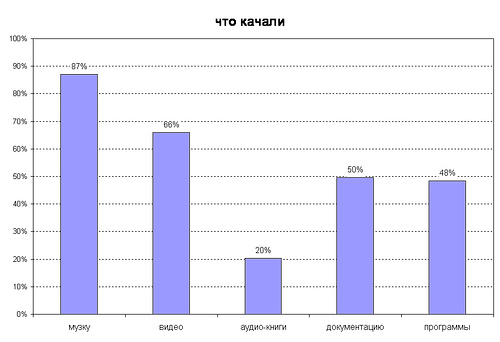 Chart 6
Chart 6
The following graph shows that the main sources of video for Americans are the purchase of licensed DVDs, cable television and online rental. And the Russians do not yet have an online DVD rental, but the percentage of pirated discs is high. Thus, even if possible, three or four out of every ten people pay for the video for free.
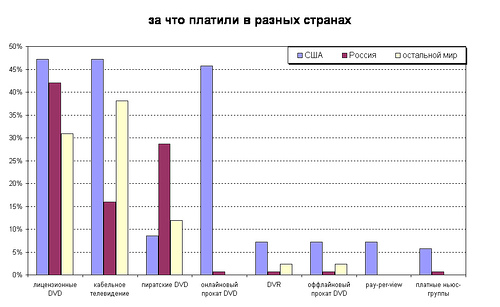 Chart 8
WHERE FROM
Chart 8
WHERE FROM
ALL
The countries that answered were distributed as follows:
 Chart 9
Chart 9
WHERE HERE TAKE AND HOW MUCH LOAD MUSIC
Decomposition described in Chart 3 about downloading music by geography:
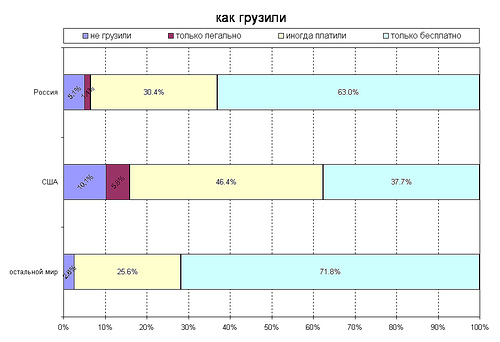 Chart 10
Chart 10
The same, with the highlight of SF Bay Area:
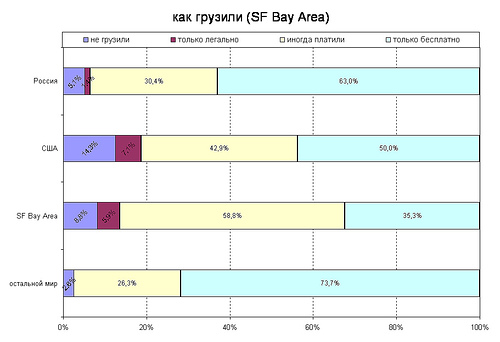 Chart 11
Chart 11
In San Francisco Bay Area pay for music, one and a half times more often than in the rest of America, and twice as often as Russia.
By free downloads, the "rest of the world" has overtaken both Russia and America.
* * * *
In 70% of those surveyed, most of the music came from free downloads:
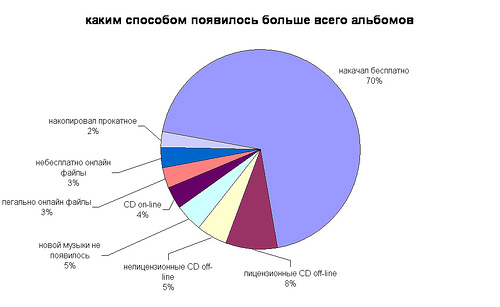 Chart 12
Chart 12
As already noted in Chart 5 , where the number of downloads was counted, the majority of people don’t download files all day, even when there’s nothing at all pays. The need for new music for most people is very modest, regardless of its cost.
A little more about these calculations:
- almost 30% load very little - they have no more than three new albums in the last three months;
- 14% generally listened to what they had before, or bought music offline
- up to a dozen albums in three months (i.e., 1 ... 3 albums per month) appeared by any means (including downloading and buying offline) from the other 23% of those polled
- 33% were loaded with any noticeable quantities ( 22% talked about the appearance of more than a dozen albums in three months, and only 11% - about many dozens).
In absolute terms:
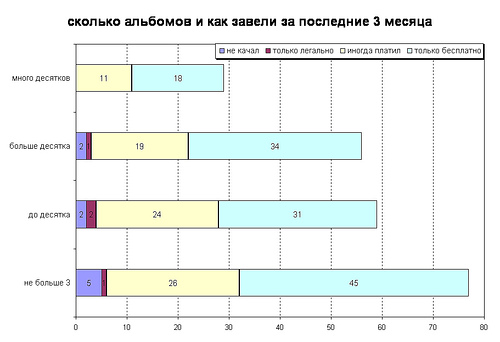 Chart 13
Chart 13
Normalized to 100% in each of the groups:
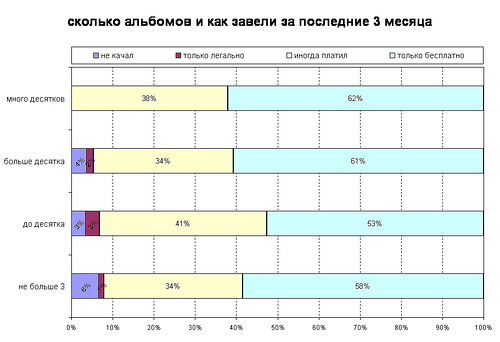 Chart 14
Chart 14
HOW TO RELEVANT TO MUSIC
Speaking of self-perception in connection with their music collections, 14% called themselves connoisseurs and collectors of rare music; 35% - simply the owners of large collections (not the fact that they constantly listen to everything collected); half of the respondents do not perceive music at all as something affecting their self-identification.
WHAT MUSIC IS LISTENED FOR
Half of the people listen to music on a computer.
For almost the third part (29%) of the survey participants, the main sound reproducing device is an mp3 player.
 Chart 15
Chart 15
The distribution of audio players around the world showed that the most popular type of players is flash-mp3 players - in the world every fifth person uses it.
The prevalence of players with hard drives of tens of gigabytes, allowing you to carry most of the actively listened collection, is 4 times higher in America than in Russia and the rest of the world.
The most popular audio devices outside the United States are a computer and a flash-mp3 player.
CD / mp3 players (playing audio or mp3-CDs) in the United States are used as the main source of sound 5 times less than in Russia and the world.
High-resolution audio players (SACD or DVD-Audio) in America listen to more than 5 times more than in the world outside of Russia, and Russian survey participants did not indicate them at all as the main source of sound.
Users of satellite radio as the main source of sound among the survey participants were not found anywhere.
WHERE / WHAT SHIPPING
The most popular method of downloading turned out to be file hosting services (the one where you can poke a link in the browser) - 65% of those who downloaded used this method. The following popular methods require installing programs for downloading on computers: BitTorrent (43%) on the second; eMule (aka “donkey”) - in third (39%) places.
11% of respondents sometimes bought content legally (from sites like iTunes, eMusic, napster, and other legal sources).
Non-free sources used 18%.
One person could use more than one download method.
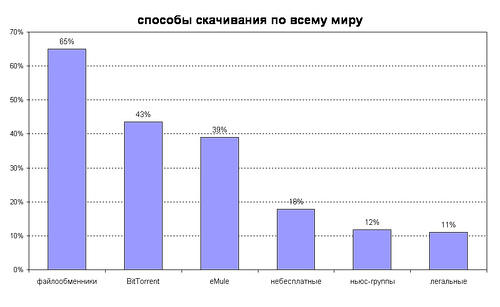 Chart 16
Chart 16
The geographic distribution of download methods shows that in the USA and in Russia , 19% of respondents in each country and 12% in the rest of the world used non-free sources .
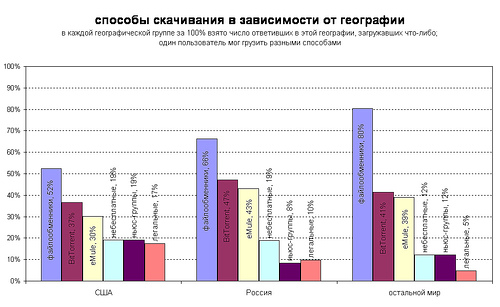 Chart 17
Chart 17
The following chart shows how different download methods fit together with individual respondents:
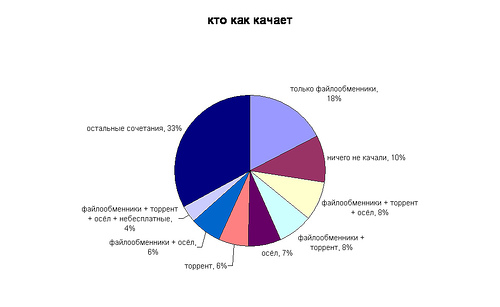 Chart 18
Chart 18
DOWNLOADING VIDEOS and MOVIES TO CINEMA
Two-thirds of those polled (66%) downloaded the video a little less than music (87%).
Distribution of the world presented in Chart 6 :
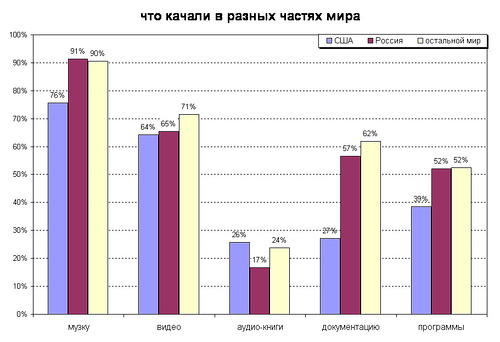 Chart 19
Chart 19
Owners of very large collections of cinema (many hundreds / thousands of films) are few in number and seem to be more passionate about collecting a movie than watching it. :)
Those whose collections number tens / hundreds of films (such 31%) are more likely to go to the cinema on average:
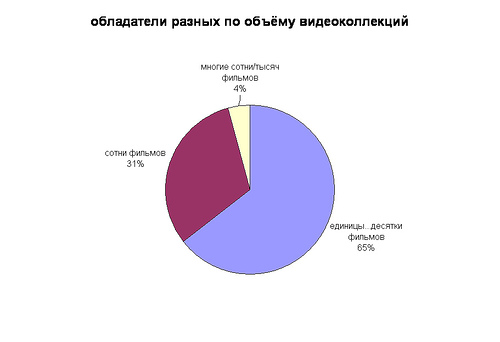 Chart 20
Chart 20
 Chart 21
Chart 21
 Chart 22
Chart 22
If it were necessary to draw any conclusions from the described situation, they could be, for example, such:
- Not far off the end of the era of music CDs and DVDs. Music retail dying in America is happening right before our eyes. With cinema, it can be slowed down by the arrival of cheap BlueRay and HD-DVD players, but so far there is no feeling that this can happen sooner than in a year. The extraction of music and cinema via the Internet has ceased to be the lot of computer freaks.
- The scream of copyright holders about the damage from piracy is no more than a pose. Those 9% who pump a lot and for free are most likely insolvent demand. The rest is much and not necessary, regardless of price. And when the distribution of content is organized conveniently, a third of the people do not mind paying reasonable money now. Apparently, portraying the fight against piracy is still more effective than adapting to new realities.
(This report was first published in my Journal)
get the music and video " HIGHLIGHTS
=== Of every 10 LJ stories, one downloaded a lot, six - only for free, three sometimes paid.
=== Only 2% of those polled legally downloaded music ...
ABOUT THE POLL The
poll began on April 7, 2007. For three weeks, 262 Russian-speaking LJ users took part in it.
57% of them live in Russia, 27% in the USA, 16% in the rest of the world.
I selected the American survey participants from the San Francisco Bay Area as a separate group because of the higher concentration of computer-literate people in these parts. Residents of the Bay Area accounted for 14% of the total number of respondents, the rest of America - 13%.
About terminology about downloading:
- free - This is from a donkey, newsgroups, torrent, regional network, as a souvenir on a self-written blank from a friend, copied from the library, etc., where you are not charged anything for accessing these files;
- not free - it’s for money, but less than usual in official American stores like iTunes, i.e., for example, on allofmp3.com, delit.net, mp3spy.ru, getmusic.ru, yanga.ru, etc. n., - everything that may be legal in Russia, but definitely angers copyright holders in America;
- legally - this is when a song is for 99 cents or more, an episode of a TV show for two green rubles, and a movie for 10 ... 15, OR music and movies from a rental office or library (not in copies), OR recorded on a DVR when you pay for this service to a cable provider, OR purchased in an ordinary store, OR in Ibei, but in a real box / package, etc.
MUSIC The
poll once again confirmed that the world is changing.
CDs replaced vinyl records once. Now they are being superseded by mp3 files, which often get from the Internet to computers and then to players, bypassing physical media. When asked why they play music most of the time, 57% of respondents said they listen to music on a computer; 29% are in mp3 players (while 20% are in flash players, the rest are in players with built-in hard drive). Thus, for 87%, audio files have already become what a couple of dozen years ago for the majority were vinyl records and compact cassettes.
 Chart 1
Chart 1 (all charts can be opened in a separate window - they will be easier to read)
* * * *
Those who spend a lot of time at the computer spend money on arranging the world in which they live - it happens that they pay for downloading music. Those who are at the computer no more than two hours a day are much more likely to get music off-line, but they don’t pay for downloading.
 Chart 2
Chart 2 * * * *
Free download of music among Russian-speaking users of LiveJournal is widespread - 92% of those who answer are able and find where to download, not paying attention to legality.
58% of the survey participants downloaded only for free, 34% sometimes paid. Only 2% of respondents downloaded only legally. 6% did not download at all.
 Chart 3
Chart 3Upon closer inspection, 92% of downloads look free, however, less impressive: most of them download quite a bit. 53% of respondents received up to 3 albums per month (by all means - uploading, copying, buying in off-line stores, etc.).
 Chart 4
Chart 4 Only 9% downloads a lot of music for free. “Many” are the many dozens of new albums that have appeared in their last three months.
 Chart 5
Chart 5 VIDEO
Video shakes a little less people than music:
 Chart 6
Chart 6The following graph shows that the main sources of video for Americans are the purchase of licensed DVDs, cable television and online rental. And the Russians do not yet have an online DVD rental, but the percentage of pirated discs is high. Thus, even if possible, three or four out of every ten people pay for the video for free.
 Chart 8
WHERE FROM
Chart 8
WHERE FROM ALL
The countries that answered were distributed as follows:
 Chart 9
Chart 9 WHERE HERE TAKE AND HOW MUCH LOAD MUSIC
Decomposition described in Chart 3 about downloading music by geography:
 Chart 10
Chart 10 The same, with the highlight of SF Bay Area:
 Chart 11
Chart 11 In San Francisco Bay Area pay for music, one and a half times more often than in the rest of America, and twice as often as Russia.
By free downloads, the "rest of the world" has overtaken both Russia and America.
* * * *
In 70% of those surveyed, most of the music came from free downloads:
 Chart 12
Chart 12 As already noted in Chart 5 , where the number of downloads was counted, the majority of people don’t download files all day, even when there’s nothing at all pays. The need for new music for most people is very modest, regardless of its cost.
A little more about these calculations:
- almost 30% load very little - they have no more than three new albums in the last three months;
- 14% generally listened to what they had before, or bought music offline
- up to a dozen albums in three months (i.e., 1 ... 3 albums per month) appeared by any means (including downloading and buying offline) from the other 23% of those polled
- 33% were loaded with any noticeable quantities ( 22% talked about the appearance of more than a dozen albums in three months, and only 11% - about many dozens).
In absolute terms:
 Chart 13
Chart 13 Normalized to 100% in each of the groups:
 Chart 14
Chart 14 HOW TO RELEVANT TO MUSIC
Speaking of self-perception in connection with their music collections, 14% called themselves connoisseurs and collectors of rare music; 35% - simply the owners of large collections (not the fact that they constantly listen to everything collected); half of the respondents do not perceive music at all as something affecting their self-identification.
WHAT MUSIC IS LISTENED FOR
Half of the people listen to music on a computer.
For almost the third part (29%) of the survey participants, the main sound reproducing device is an mp3 player.
 Chart 15
Chart 15 The distribution of audio players around the world showed that the most popular type of players is flash-mp3 players - in the world every fifth person uses it.
The prevalence of players with hard drives of tens of gigabytes, allowing you to carry most of the actively listened collection, is 4 times higher in America than in Russia and the rest of the world.
The most popular audio devices outside the United States are a computer and a flash-mp3 player.
CD / mp3 players (playing audio or mp3-CDs) in the United States are used as the main source of sound 5 times less than in Russia and the world.
High-resolution audio players (SACD or DVD-Audio) in America listen to more than 5 times more than in the world outside of Russia, and Russian survey participants did not indicate them at all as the main source of sound.
Users of satellite radio as the main source of sound among the survey participants were not found anywhere.
WHERE / WHAT SHIPPING
The most popular method of downloading turned out to be file hosting services (the one where you can poke a link in the browser) - 65% of those who downloaded used this method. The following popular methods require installing programs for downloading on computers: BitTorrent (43%) on the second; eMule (aka “donkey”) - in third (39%) places.
11% of respondents sometimes bought content legally (from sites like iTunes, eMusic, napster, and other legal sources).
Non-free sources used 18%.
One person could use more than one download method.
 Chart 16
Chart 16 The geographic distribution of download methods shows that in the USA and in Russia , 19% of respondents in each country and 12% in the rest of the world used non-free sources .
 Chart 17
Chart 17 The following chart shows how different download methods fit together with individual respondents:
 Chart 18
Chart 18 DOWNLOADING VIDEOS and MOVIES TO CINEMA
Two-thirds of those polled (66%) downloaded the video a little less than music (87%).
Distribution of the world presented in Chart 6 :
 Chart 19
Chart 19 Owners of very large collections of cinema (many hundreds / thousands of films) are few in number and seem to be more passionate about collecting a movie than watching it. :)
Those whose collections number tens / hundreds of films (such 31%) are more likely to go to the cinema on average:
 Chart 20
Chart 20  Chart 21
Chart 21  Chart 22
Chart 22 If it were necessary to draw any conclusions from the described situation, they could be, for example, such:
- Not far off the end of the era of music CDs and DVDs. Music retail dying in America is happening right before our eyes. With cinema, it can be slowed down by the arrival of cheap BlueRay and HD-DVD players, but so far there is no feeling that this can happen sooner than in a year. The extraction of music and cinema via the Internet has ceased to be the lot of computer freaks.
- The scream of copyright holders about the damage from piracy is no more than a pose. Those 9% who pump a lot and for free are most likely insolvent demand. The rest is much and not necessary, regardless of price. And when the distribution of content is organized conveniently, a third of the people do not mind paying reasonable money now. Apparently, portraying the fight against piracy is still more effective than adapting to new realities.
(This report was first published in my Journal)
